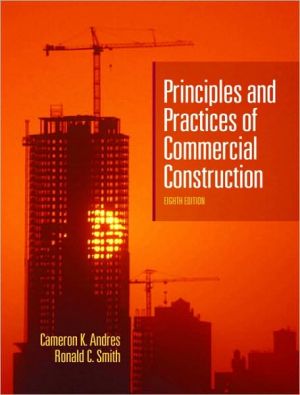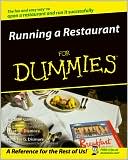Principles and Practices of Commercial Construction
The revision of this classic text provides a well-illustrated and logical engineering approach to the principles and building practices used in the construction of commercial buildings. Principles and Practices of Commercial Construction presents an overview of the methods, equipment, and materials used while covering each phase of the construction process in a sequential, chapter-by-chapter format. Progressing from site evaluation and layout to interior and building finishes, this edition...
Search in google:
This classic book provides an overview of the methods, equipment, and materials used in the construction of large commercial buildings. It makes an excellent source of general information—complete with diagrams, details, photographs, and worked examples of typical construction calculations such as earth moving calculation, formwork calculations, concrete pressures, and insulation values for building components. Revised content in this new 8th edition includes additional examples and homework problems for a complete review, superior illustrations, added video clips to the ancillary materials, and much, much more! Booknews The fifth edition provides all the essential information along with the most current metric conversion of tables, test methods, product sizes, and loads. Topics include site investigation, site layout, excavations and excavating equipment, foundation layout, foundations, formwork, concrete work, structural timber frame, reinforced concrete frame, structural steel frame, floor systems and industrial flooring, roof systems and industrial roofing, masonry construction, curtain wall construction, building insulation, and finishing. Annotation c. by Book News, Inc., Portland, Or.
The process of commercial construction brings together designers, engineers, project managers, fabricators, and site personnel, as well as heavy equipment, to build commercial buildings.\ Many demands are made on the building process: (1) the project must be completed on time and on budget; (2) it must meet all relevant building codes and environmental concerns; and (3) it must function as intended. Although "form for function" does not fall within the scope of this text, it is important to acknowledge that a building should accommodate, enhance, and enliven its intended use.\ A combination of time-honored building practices, space age materials, and computer-based design offers the construction industry an increasingly formula-based approach to construction. The use of standardized building elements such as joists, trusses, beams, concrete floor slabs, curtain walls, and entire building frames has directed the manufacture of preengineered building components, whether they are structural or not. Catalog selection of structural components and non-structural items offer a cost-effective solution for many owners. However, preengineered components increasingly challenge designers and site personnel to pay greater attention to detail.\ As the construction process becomes ever more refined, it is essential that manufacturers, suppliers, designers, and contractors speak a common language. That language includes an understanding of common industry terms and definitions, the ability to read and interpret complex drawings and details, and a strong working knowledge of the complete building process. The language of construction also includes measurement of quantities. Measurementson the construction site must be within the allowable tolerances of the prefabricated items to ensure speedy assembly. Drawings, specifications, and details must be clear and accurate. Because the industry relies on both standard and metric units of measure, all construction personnel need to be well versed in both systems. To reinforce this need, the seventh edition of Principles and Practices of Commercial Construction provides material dimensions, tables, details, and worked examples in both standard and metric units.\ When conditions and need dictate a custom approach, site personnel must be able to respond. The use of traditional materials, such as poured reinforced concrete, require skilled site personnel to plan, monitor, and execute the construction process in a timely manner. It is imperative that students entering the construction field as designers, project managers, and construction supervisors have an understanding of the complete construction process and an ability to meld traditional methods and materials with new concepts. Qualified tradespeople provide the expertise necessary to erect and assemble the structure; they too benefit from an understanding of the entire construction process.\ The seventh edition of Principles and Practices of Commercial Construction continues in the same vein as the previous edition. It provides the reader with a complete overview of traditional concepts and practices as well as preengineered components that are used in the construction of commercial buildings. From building layout to exterior finishing, this edition describes and illustrates the various stages of the building process. New materials and new concepts are outlined throughout the text, introducing the reader to current practices in commercial construction.\ Traditional materials used in the construction of the structural frame—timber, steel, and concrete—are described in detail. The physical properties of each material are discussed, and a description of the structural components made from each material is provided. Tests for quality control and proper methods of application for each material are also outlined.\ In response to new ideas, materials, and innovations, diagrams have been revised and photographs have been added or changed throughout the seventh edition. Additional information has been provided on excavation wall bracing in Chapter 3, including guidelines for safe working conditions in trenches. In Chapter 5, additional information on soil stabilization and the use of mini piles has been added. Chapter 6 provides additional calculations of formwork to better illustrate the effects of concrete pressures within wall formwork of different heights. Chapter 7 provides additional information on concrete admixtures for concrete mixes, and Chapter 12 adds additional information on single-ply roofing membranes and insulation requirements for roofs. Chapter 15 revises the discussion on building insulation to reflect current theories and practices in building envelope construction; a discussion on construction sealants and adhesives has also been added. Chapter 16 includes additional information on stucco coatings and the use of wood siding. The discussion on thermal efficiency of windows has also been enhanced. Additional review questions have been added to Chapters 1, 2, 3, and 10.\ It is hoped that students engaged in construction-related technologies and trade apprenticeship programs continue to find Principles and Practices of Commercial Construction a useful overview of the construction process. An instructor's manual is provided with answers to all review questions and suggestions for additional class exercises and group projects.
Preface1Site Investigation12Site Layout183Excavations and Excavating Equipment454Foundation Layout905Foundations1006Formwork1207Concrete Work1748Structural Timber Frame2239Reinforced Concrete Frame25610Structural Steel Frame29511Floor Systems and Industrial Flooring31912Roof Systems and Industrial Roofing35113Masonry Construction38914Curtain Wall Construction41615Building Insulation43516Finishing453Glossary481Index485
\ BooknewsThe fifth edition provides all the essential information along with the most current metric conversion of tables, test methods, product sizes, and loads. Topics include site investigation, site layout, excavations and excavating equipment, foundation layout, foundations, formwork, concrete work, structural timber frame, reinforced concrete frame, structural steel frame, floor systems and industrial flooring, roof systems and industrial roofing, masonry construction, curtain wall construction, building insulation, and finishing. Annotation c. by Book News, Inc., Portland, Or.\ \ \ \ \ BooknewsThis textbook concentrates on the basic methods, equipment, and materials used in the construction of a large structure. The sixth edition provides tables and charts in both standard and metric units. Annotation c. Book News, Inc., Portland, OR (booknews.com)\ \








